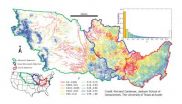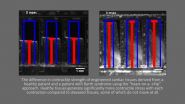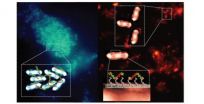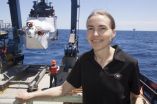(Press-News.org) Microbial samples taken from populations living in the U.S. and Tanzania reveal that the microbiome of the human hand is more varied than previously thought, according to new research published in the journal Microbiology. These findings suggest that the 'standard' hand microbiome varies depending on location and lifestyle.
Results compared the microbes on the hands of women in the U.S. and Tanzania and found that organisms that have commonly been identified in prior human skin microbiome studies were highly abundant on U.S. hands, while the most abundant bacterial species on Tanzanian hands were associated with the environment, particularly soil.
The team of researchers from Yale University, Stanford University and Johns Hopkins University Bloomberg School of Public Health, took hand wash samples from 15 adult American women and 29 adult Tanzanian women to compare the species of microorganisms present. In the U.S. group, all participants were graduate students, 13 of white European origin, while two were Chinese-American. In the Tanzanian group, all women were caregivers to children under 5 years of age, living in a low-income urban environment.
Dr Jordan Peccia from Yale University, who led the work, said: "If we ever hope to understand how the microbiome affects health and how environmental interactions alter it, we have to expand research to cover different populations.
"The microbial population on the graduate students' hands looks like what we think the hand microbiome 'should look like', but we can't assume that the human microbiome is a standard thing. Our research has shown that the microbial population on the things people use to interact with the environment the most – their hands – is dramatically different between groups."
The predominant microbial groups found on the US hands included members of the Propionibacteriaceae, Staphylococcaceae and Streptococcacease groups of bacteria, similar to those previously found in hand microbiome studies. In contrast, the Tanzanian samples included members of the Rhodobacteraceae and Nocardiodaceae not previously thought to be common colonisers of human skin. These groups are commonly associated with soil and aquatic environments.
The lifestyle differences between the groups are notable. None of the U.S. group was a caregiver for young children and the group spent the majority of their time indoors. The Tanzanian women live in open-air dwellings in Dar es Salaam, Tanzania, and spend large amounts of time outdoors.
These results help to expand human microbiome results beyond U.S. and European populations, demonstrating the important role that the environment plays in shaping the microbes on people's hands.
INFORMATION: END
Research suggests human microbiome studies should include a wider diversity of populations
2014-05-12
ELSE PRESS RELEASES FROM THIS DATE:
Ice-loss moves the Earth 250 miles down
2014-05-12
At the surface, Antarctica is a motionless and frozen landscape. Yet hundreds of miles down the Earth is moving at a rapid rate, new research has shown.
The study, led by Newcastle University, UK, and published this week in Earth and Planetary Science Letters, explains for the first time why the upward motion of the Earth's crust in the Northern Antarctic Peninsula is currently taking place so quickly.
Previous studies have shown the earth is 'rebounding' due to the overlying ice sheet shrinking in response to climate change. This movement of the land was understood ...
Green-energy community projects need better government backing
2014-05-12
Community-led sustainable energy projects are not taken seriously enough by the government, according to a new report from the University of East Anglia.
Published today, the report looks at how initiatives such as community-owned solar panels, wind turbines and hydro-electricity generators, as well as energy-saving projects, could make big differences in tackling climate change.
But while a 'Big Society' ethos has formed part of the legislative programme for the coalition government, and the UK Government's new Community Energy Strategy has been a big step forward ...
Atlas shows how genes affect our metabolism
2014-05-11
In the most comprehensive exploration of the association between genetic variation and human metabolism, researchers have provided unprecedented insights into how genetic variants influence complex disease and drug response through metabolic pathways.
The team has linked 145 genetic regions with more than 400 molecules involved in human metabolism in human blood. This atlas of genetic associations with metabolism provides many new opportunities to understand the molecular pathways underlying associations with common, complex diseases.
Metabolic molecules, known as metabolites, ...
Flexible supercapacitor raises bar for volumetric energy density
2014-05-11
Scientists have taken a large step toward making a fiber-like energy storage device that can be woven into clothing and power wearable medical monitors, communications equipment or other small electronics.
The device is a supercapacitor—a cousin to the battery. This one packs an interconnected network of graphene and carbon nanotubes so tightly that it stores energy comparable to some thin-film lithium batteries—an area where batteries have traditionally held a large advantage.
The product's developers, engineers and scientists at Nanyang Technological University (NTU) ...
Hydrologists find Mississippi River network's buffering system for nitrates is overwhelmed
2014-05-11
AUSTIN, Texas – A new method of measuring the interaction of surface water and groundwater along the length of the Mississippi River network adds fresh evidence that the network's natural ability to chemically filter out nitrates is being overwhelmed.
The research by hydrogeologists at The University of Texas at Austin, which appears in the May 11 edition of the journal Nature Geoscience, shows for the first time that virtually every drop of water coursing through 311,000 miles (500,000 kilometers) of waterways in the Mississippi River network goes through a natural ...
Patient stem cells used to make 'heart disease-on-a-chip'
2014-05-11
Cambridge, MA—Harvard scientists have merged stem cell and 'organ-on-a-chip' technologies to grow, for the first time, functioning human heart tissue carrying an inherited cardiovascular disease. The research appears to be a big step forward for personalized medicine, as it is working proof that a chunk of tissue containing a patient's specific genetic disorder can be replicated in the laboratory.
The work, published in Nature Medicine, is the result of a collaborative effort bringing together scientists from the Harvard Stem Cell Institute, the Wyss Institute for Biologically ...
Ocean winds keep Antarctica cold, Australia dry
2014-05-11
VIDEO:
Dr. Nerlie Abram, from the Australian National University, explains why ocean winds have stopped Antarctica from warming as much as other continents. Her research also explains droughts in Southern Australia.
Click here for more information.
New Australian National University-led research has explained why Antarctica is not warming as much as other continents, and why southern Australia is recording more droughts.
Researchers have found rising levels of carbon dioxide ...
Hijacking bacteria's natural defences to trap and reveal pathogens
2014-05-11
The breakthrough, published in the journal Nature Materials, could offer an easier way of detecting pathogenic bacteria outside of a clinical setting and could be particularly important for the developing world, where access to more sophisticated laboratory techniques is often limited.
The research was led by Professor Cameron Alexander, Head of the Division of Drug Delivery and Tissue Engineering and EPSRC Leadership Fellow in the University's School of Pharmacy, building on work by PhD student Peter Magennis. Professor Alexander said: "Essentially, we have hijacked ...
UGA research examines fate of methane following the Deepwater Horizon spill
2014-05-11
Athens, Ga. – The 2010 Deepwater Horizon blowout discharged roughly five million gallons of oil and up to 500,000 tons of natural gas into Gulf of Mexico offshore waters over a period of 84 days. In the face of a seemingly insurmountable cleanup effort, many were relieved by reports following the disaster that naturally-occurring microbes had consumed much of the gas and oil.
Now, a team of researchers led by University of Georgia marine scientists have published a paper in the journal Nature Geoscience that questions this conclusion and provides evidence that microbes ...
Galectins direct immunity against bacteria that employ camouflage
2014-05-11
Our bodies produce a family of proteins that recognize and kill bacteria whose carbohydrate coatings resemble those of our own cells too closely, scientists have discovered.
Called galectins, these proteins recognize carbohydrates from a broad range of disease-causing bacteria, and could potentially be deployed as antibiotics to treat certain infections. The results are scheduled for publication in Nature Chemical Biology.
Researchers at Emory University School of Medicine made the discovery with the aid of glass slides coated with an array of over 300 different glycans ...





